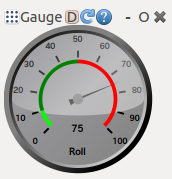|
Size: 1998
Comment:
|
Size: 2488
Comment:
|
| Deletions are marked like this. | Additions are marked like this. |
| Line 57: | Line 57: |
| (The extra argument here ensures that a new plugin is found.) Navigate to Plugins-->Visualization-->Gauges to add the gauge plugin. It will launch with some default parameters on the ROS parameter server. They can be adjusted from C++, Python, or the command line. See http://wiki.ros.org/Parameter%20Server. The parameters are: | (The extra argument here ensures that a new plugin is found.) Navigate to Plugins-->Visualization-->Gauges to add the gauge plugin. It will launch with some default parameters on the ROS parameter server. They can be adjusted from C++, Python, or the command line. See http://wiki.ros.org/Parameter%20Server. These parameters are numbered so you can launch several gauges with unique parameters. They are: |
| Line 59: | Line 59: |
| * "gauge_name" -- The name displayed below the gauge. * "minimum" -- The minimum value shown on the gauge. * "maximum" -- The maximum value shown on the gauge. * "danger_threshold" -- Show a color band, with red beginning at this value. * "topic" -- The name of the topic that controls the needle. * "pixel_size" -- The width and height of the gauge. |
* "gauge_nameX" -- The name displayed below gauge X. * "minimumX" -- The minimum value shown on gauge X. * "maximumX" -- The maximum value shown on gauge X. * "danger_thresholdX" -- Show a color band, with red beginning at this value. * "topicX" -- The name of the topic that controls needle X. * "pixel_sizeX" -- The width and height of gaugeX. This example launches two gauges which listen to different topics (pitch and yaw): {{{ $ rosparam set /rqt_gauges/topic1 /pitch $ rosparam set /rqt_gauges/gauge_name1 Pitch $ rosparam set /rqt_gauges/topic2 /yaw $ rosparam set /rqt_gauges/gauge_name2 Yaw $ rostopic pub -r 1 /pitch std_msgs/Float64 13 $ rostopic pub -r 1 /yaw std_msgs/Float64 57 $ rqt Then select two Gauges from the drop-down menu. }}} |
Only released in EOL distros:
Package Summary
Launch virtual gauges for ROS topics.
- Maintainer status: maintained
- Maintainer: andyz <andyz AT utexas DOT edu>
- Author: alexvs <andyz AT utexas DOT edu>
- License: See License.txt
- Source: git https://github.com/UTNuclearRoboticsPublic/gauges.git (branch: master)
Package Summary
Launch virtual gauges for ROS topics.
- Maintainer status: maintained
- Maintainer: andyz <andyz AT utexas DOT edu>
- Author: alexvs <andyz AT utexas DOT edu>
- License: See License.txt
- Source: git https://github.com/UTNuclearRoboticsPublic/gauges.git (branch: master)
Package Summary
Launch virtual gauges for ROS topics.
- Maintainer status: maintained
- Maintainer: andyz <andyz AT utexas DOT edu>
- Author: alexvs <andyz AT utexas DOT edu>
- License: See License.txt
- Source: git https://github.com/UTNuclearRoboticsPublic/gauges.git (branch: master)
Contents
Launch virtual gauges for ROS topics.

Installation
Install the debian:
$ sudo apt-get install ros-indigo-gauges
Or, install from source to get the most current version:
$ mkdir -p ~/Desktop/catkin_ws/src $ cd ~/Desktop/catkin_ws/src $ catkin_init_workspace
Clone the package
$ git clone https://github.com/UTNuclearRoboticsPublic/gauges.git $ cd ..
Build the package
$ catkin_make
Source the new files
$ source devel/setup.bash
(You may have to do this every time you open a new terminal window, or add this line to your bashrc: source ~/Desktop/catkin_ws/devel/setup.bash)
Standalone app
Use a launch file to specify your gauges. See the example in launch/pitch_yaw_gauges.launch.
Usage:
$ roslaunch gauges pitch_yaw_gauges.launch $ rostopic pub -r 1 /pitch std_msgs/Float64 53.1 $ rostopic pub -r 10 -- /yaw std_msgs/Float64 -10.5
The second two commands publish data for the gauges to listen to.
rqt plugin
You can easily open a virtual gauge within the rqt GUI environment. Launch the main rqt window:
$ rqt --force-discover
(The extra argument here ensures that a new plugin is found.) Navigate to Plugins-->Visualization-->Gauges to add the gauge plugin. It will launch with some default parameters on the ROS parameter server. They can be adjusted from C++, Python, or the command line. See http://wiki.ros.org/Parameter%20Server. These parameters are numbered so you can launch several gauges with unique parameters. They are:
- "gauge_nameX" -- The name displayed below gauge X.
- "minimumX" -- The minimum value shown on gauge X.
- "maximumX" -- The maximum value shown on gauge X.
- "danger_thresholdX" -- Show a color band, with red beginning at this value.
- "topicX" -- The name of the topic that controls needle X.
- "pixel_sizeX" -- The width and height of gaugeX.
This example launches two gauges which listen to different topics (pitch and yaw):
$ rosparam set /rqt_gauges/topic1 /pitch $ rosparam set /rqt_gauges/gauge_name1 Pitch $ rosparam set /rqt_gauges/topic2 /yaw $ rosparam set /rqt_gauges/gauge_name2 Yaw $ rostopic pub -r 1 /pitch std_msgs/Float64 13 $ rostopic pub -r 1 /yaw std_msgs/Float64 57 $ rqt Then select two Gauges from the drop-down menu.







